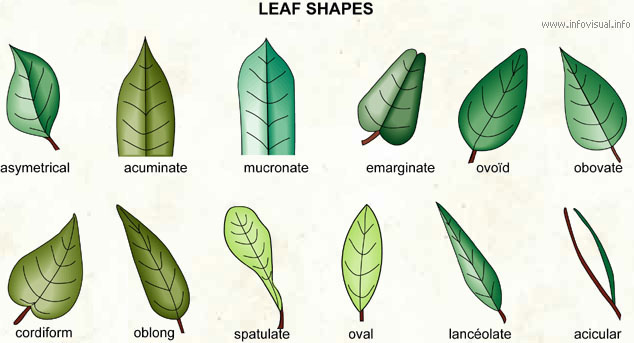Leaf shapes (1)

Asymmetrical: completely unsymmetrical.
Acuminate: leaf that tapers into a long point.
Mucronate: leaf with an extended central vein.
Emarginate: notched at the end.
Ovoid: egg-shaped.
Obovate: resembling an upside-down egg.
Cordiform: heart-shaped.
Oblong: elongated shape.
Spatulate: shaped like a spatula.
Oval: elliptical.
Lanceolate: shaped like the head of a lance.
Acicular: needle-shaped.
Photo :

In botany, a leaf is an above-ground plant organ specialized for photosynthesis. For this purpose, a leaf is typically flat (laminar) and thin, to expose the cells containing chloroplast to light over a broad area, and to allow light to penetrate fully into the tissues. Leaves are also the sites in most plants where transpiration and guttation take place. Leaves can store food and water, and are modified in some plants for other purposes. The comparable structures of ferns are correctly referred to as fronds. Furthermore, leaves are prominent in the human diet as leaf vegetables.
A structurally complete leaf of an angiosperm consists of a petiole (leaf stem), a lamina (leaf blade), and stipules (small processes located to either side of the base of the petiole). The petiole attaches to the stem at a point called the "leaf axil". Not every species produces leaves with all of the aforementioned structural components. In some species, paired stipules are not obvious or are absent altogether. A petiole may be absent, or the blade may not be laminar (flattened). The tremendous variety shown in leaf structure (anatomy) from species to species is presented in detail below under Leaf morphology. After a period of time (i.e. seasonally, during the autumn), deciduous trees shed their leaves. These leaves then decompose into the soil. External leaf characteristics (such as shape, margin, hairs, etc.) are important for identifying plant species, and botanists have developed a rich terminology for describing leaf characteristics. These structures are a part of what makes leaves determinant; they grow and achieve a specific pattern and shape, then stop. Other plant parts like stems or roots are non-determinant, and will usually continue to grow as long as they have the resources to do so.